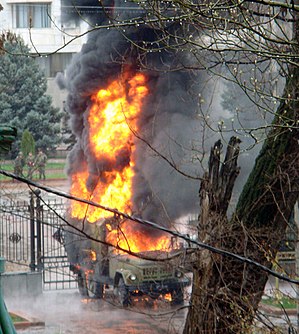| 2010 Kyrgyz Revolution | |||
|---|---|---|---|
 An opposition-captured vehicle burns near the capitol building during citywide protests and riots in Bishkek, Kyrgyzstan on 7 April 2010. Guards can be seen to the left of the smoke. | |||
| Date | 6 April – 15 April 2010 (1 week and 2 days) | ||
| Location | |||
| Caused by |
| ||
| Methods | Protests, riots | ||
| Resulted in | Democratization of Kyrgyzstan
| ||
| Parties | |||
| Lead figures | |||
| |||
| Number | |||
| |||
| Casualties and losses | |||
| |||
The 2010 Kyrgyz Revolution, also known as the Second Kyrgyz Revolution, the Melon Revolution,[1][2][3][4] the April Events (Kyrgyz: Апрель окуясы, romanized: Aprel okuyasy)[5] or officially as the People's April Revolution,[6] began in April 2010 with the ousting of Kyrgyz president Kurmanbek Bakiyev in the capital Bishkek. It was followed by increased ethnic tension involving Kyrgyz people and Uzbeks in the south of the country, which escalated in June 2010. The violence ultimately led to the consolidation of a new parliamentary system in Kyrgyzstan.
During the general mayhem, exiles from the Uzbek minority claim they were assaulted and driven to Uzbekistan, with some 400,000 Kyrgyzstani citizens becoming internally displaced.[7] Victims interviewed by media and aid workers testify to mass killing, gang rape and torture.[8] Then-head of the Interim government Roza Otunbayeva indicated that the death toll is tenfold higher than was previously reported, which brings the number of the dead to 2,000 people.
- ^ Isayev, Boris (6 April 2019). Политическая история: революции. Учебник для бакалавриата и магистратуры. ЛитРес. p. 278. ISBN 9785041554125.
- ^ "Volksparteien verlieren Parteivolk". Центр Льва Гумилёва (in Russian). 12 September 2015.
- ^ "Why 'Color Revolutions' Can't Be Exported". Bloomberg News. 15 February 2018.
- ^ "Zweischneidige Sanktionen gegen Russland". Allgemeine Schweizerische Militärzeitschrift (in German). April 2015.
- ^ DZHUMASHOVA, Aida (7 April 2018). "Asiya Sasykbaeva: It is blasphemy to mark April events".
- ^ Matveeva, Anna; Savin, Igor; Faizullaev, Bahrom (April 2012). "Kyrgyzstan: Tragedy in the South" (PDF). Ethnopolitics Papers. Vol. 17. Archived (PDF) from the original on 7 May 2016.
- ^ Harding, Luke (17 June 2010). "Uzbek refugees from Kyrgyzstan pogrom vow to return". The Guardian. London.
- ^ "Victims recount horrors of ethnic violence in Kyrgyzstan". CNN. 17 June 2010.